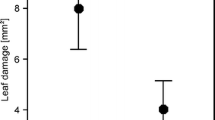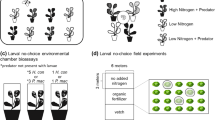Abstract
The arrangement, number, and size of plant parts may influence predator foraging behavior, either directly, by altering the rate or pattern of predator movement, or, indirectly, by affecting the distribution and abundance of prey. We report on the effects of both plant architecture and prey distribution on foraging by the predatory mite, Phytoseiulus persimilis Athias-Henriot (Acari: Phytoseiidae), on cucumber (Cucumis sativus L.). Plants differed in leaf number (2- or 6-leafed), and there were associated differences in leaf size, plant height, and relative proportions of plant parts; but all had the same total surface area. The prey, the twospotted spider mite Tetranychus urticae Koch (Acari: Tetranychidae), were distributed either on the basal leaf or on all leaves. The effect of plant architecture on predator foraging behavior varied depending on prey distribution. The dimensions of individual plant parts affected time allocated to moving and feeding, but they did not appear to influence the frequency with which predators moved among different plant parts. Overall, P. persimilis moved less, and fed upon prey longer, on 6-leafed plants with prey on all leaves than on plants representing other treatment combinations. Our findings suggest that both plant architecture and pattern of prey distribution should be considered, along with other factors such as herbivore-induced plant volatiles, in augmentative biological control programs.

Similar content being viewed by others
References
Andow DA, Prokrym DR (1990) Plant structural complexity and host-finding by a parasitoid. Oecologia 82:162–165
Boethel DJ, Eikenbary RD (eds) (1986) Interactions of plant resistance and parasitoids and predators of insects. Ellis Harwood, Chichester
Burbutis PP, Koepke CH (1981) European corn borer control in peppers by Trichogramma nubilale. J Econ Entomol 74:246–247
Clark TL, Messina FJ (1998a) Foraging behavior of lacewing larvae (Neuroptera: Chrysopidae) on plants with divergent architectures. J. Insect Behavior 11:303–317
Clark TL, Messina FJ (1998b) Plant architecture and the foraging success of ladybird beetles attacking the Russian wheat aphid. Entomol Exp Appl 86:153–161
Cloyd RA, Sadof CS (2000) Effects of plant architecture on the attack rate of Leptomastix dactylopii (Hymenoptera: Encyrtidae), a parasitoid of the citrus mealybug (Homoptera: Pseudococcidae). Environ Entomol 29:535–541
Cortesero AM, Stapel JO, Lewis WJ (2000) Understanding and manipulating plant attributes to enhance biological control. Biol Control 17:35–49
Dicke M (1994) Local and systemic production of volatile herbivore-induced terpenoids: their role in plant-carnivore mutualism. J Plant Physiol 143:465–472
Dicke M, Sabelis MW (1988) How plants obtain predatory mites as bodyguards. Netherlands J Zool 38:148–165
Gardner SM, Dixon AFG (1985) Plant structure and the foraging success of Aphidius rhopalosiphi (Hymenoptera: Aphidiidae). Ecol Entomol 10:171–179
Geitzenauer HL, Bernay EA (1996) Plant effects on prey choice by a vespid wasp, Polistes arizonensis. Ecol Entomol 21:227–234
Gontijo LM, Margolies DC, Nechols JR, Cloyd RA (2010) Plant architecture, prey distribution and predator release strategy interact to affect foraging efficiency of the predatory mite Phytoseiulus persimilis (Acari: Phytoseiidae) on cucumber. Biol Control 53:136–141
Gould HJ, Light WISG (1971) Biological control of Tetranychus urticae on stock plants of ornamental ivy. Plant Pathol 20:18–20
Grevstad F, Klepetka BW (1992) The influence of plant architecture on the foraging efficiencies of a suite of ladybird beetles feeding on aphids. Oecologia 92:399–404
Hamlen RA (1978) Biological control of spider mites on greenhouse ornamentals using predaceous mites. Proc Fla State Hort Soc 91:247–249
Hoddle MS (2003) The effect of prey species and environmental complexity on the functional response of Franklinothrips orizabensis: a test of the fractal foraging model. Ecol Entomol 28:309–318
Kareiva P, Sahakian R (1990) Tritrophic effects of a simple architectural mutation in pea plants. Nature 345:433–434
Krips OE, Kleijn PW, Willems PEL, Gols GJZ, Dicke M (1999) Leaf hairs influence searching efficiency and predation rate of the predatory mite Phytoseiulus persimilis (Acari: Phytoseiidae). Exp Appl Acarol 23:119–131
Legrand A, Barbosa P (2003) Plant morphological complexity impacts foraging efficiency of adult Coccinella septempunctata L. (Coleoptera: Coccinellidae). Environ Entomol 32:1219–1226
Maeda T, Takabayashi J (2001) Production of herbivore-induced plant volatiles and their attractiveness to Phytoseiulus persimilis (Acari: Phytoseiidae) with changes of Tetranychus urticae (Acari: Tetranychidae) density on a plant. Appl Entomol Zool 36(1):47–52
Maini S, Burgio G, Carrieri M (1991) Trichogramma maidis host-searching in corn vs. pepper. Fourth Eur Workshop Insect Parasit Redia 74:121–127
Nachappa P, Margolies DC, Nechols JR, Loughin T (2006) Phytoseiulus persimilis response to herbivore-induced plant volatiles as a function of mite-days. Exp Appl Acarol 40:231–239
O’Brien WJ, Browman HI, Evans BI (1990) Search strategies of foraging animals. Am Scientist 78:152–160
Price PW, Boulton CE, Gross P, McPheron BA, Thompson JN, Weis AE (1980) Interactions among three trophic levels: influence of plants on interactions between insect herbivores and natural enemies. Annu Rev Ecol Syst 11:41–65
Ryoo MI (1996) Influence of the spatial distribution pattern of prey among patches and spatial coincidence on the functional and numerical response of Phytoseiulus persimilis (Acarina, Phytoseiidae). J Appl Entomol 120:187–192
Sabelis MW, Dicke M (1985) Long-range dispersal and searching behaviour. In: Helle W, Sabelis MW (eds) Spider mites: their biology, natural enemies and control, vol 1B. Elsevier, Amsterdam, pp 141–160
SAS Institute (2002) SAS user’s guide: statistics, version 8.2. SAS Institute, Cary
Skirvin DJ, Fenlon JS (2001) Plant species modifies the functional response of Phytoseiulus persimilis (Acari: Phytoseiidae) to Tetranychus urticae (Acari: Tetranychidae): implications for biological control. Bull Entomol Res 91:61–67
Stadler B, Völkl W (1991) Foraging patterns of two aphid parasitoids, Lysiphlebus testaceipes and Aphidius colemani on banana. Entomol Exp Appl 58:221–229
Stavrinides MC, Skirvin DJ (2003) The effect of chrysanthemum leaf trichome density and prey spatial distribution on predation of Tetranychus urticae (Acari: Tetranychidae) by Phytoseiulus persimilis (Acari: Phytoseiidae). Bull Entomol Res 93:343–350
Thorpe KW (1985) Effects of height and habitat type on egg parasitism by Trichogramma minutum and T. pretiosum (Hymenoptera: Trichogrammatidae). Agric Ecosyst Environ 12:117–126
Treacy MF, Benedict JH, Segers JC, Morrison RK, Lopez JD (1986) Role of cotton trichome density in bollworm (Lep.: Noctuidae) egg parasitism. Environ Entomol 15:365–368
Turlings TCJ, Tumlinson JH, Lewis WJ (1990) Exploitation of herbivore-induced plant odors by host-seeking parasitic wasps. Science 250:1251–1253
Vinson SB (1984) How parasitoids locate their hosts: a case of insect espionage. In: Lewis T (ed) Insect communication, Academic, New York, pp 325–348
Wang B, Ferro DN, Hosmer DW (1997) Importance of plant size, distribution of egg masses, and weather conditions on egg parasitism of the European corn borer, Ostrinia nubilalis by Trichogramma ostriniae in sweet corn. Entomol Exp Appl 83:337–345
Yasuda H, Ishikawa H (1999) Effects of prey density and spatial distribution on prey consumption of the adult predatory ladybird beetle. J Appl Ent 123:474–478
Zhang ZQ, Sanderson JP (1993) Scale of aggregation in three acarine predator species with different degrees of polyphagy. Oecologia 96:24–31
Zhang ZQ, Sanderson JP, Nyrop JP (1992) Foraging time and spatial patterns of predation in experimental populations: a comparative study of three mite predator-prey systems (Acari: Phytoseiidae, Tetranychidae). Oecologia 90:185–196
Acknowledgments
We thank Xiaoli Wu for technical assistance and J. P. Michaud for reviewing the manuscript. This is Contribution Number 09-370-J from the Kansas Agricultural Experiment Station, Manhattan, KS.
Author information
Authors and Affiliations
Corresponding author
Rights and permissions
About this article
Cite this article
Gontijo, L.M., Nechols, J.R., Margolies, D.C. et al. Plant architecture and prey distribution influence foraging behavior of the predatory mite Phytoseiulus persimilis (Acari: Phytoseiidae). Exp Appl Acarol 56, 23–32 (2012). https://doi.org/10.1007/s10493-011-9496-7
Received:
Accepted:
Published:
Issue Date:
DOI: https://doi.org/10.1007/s10493-011-9496-7




